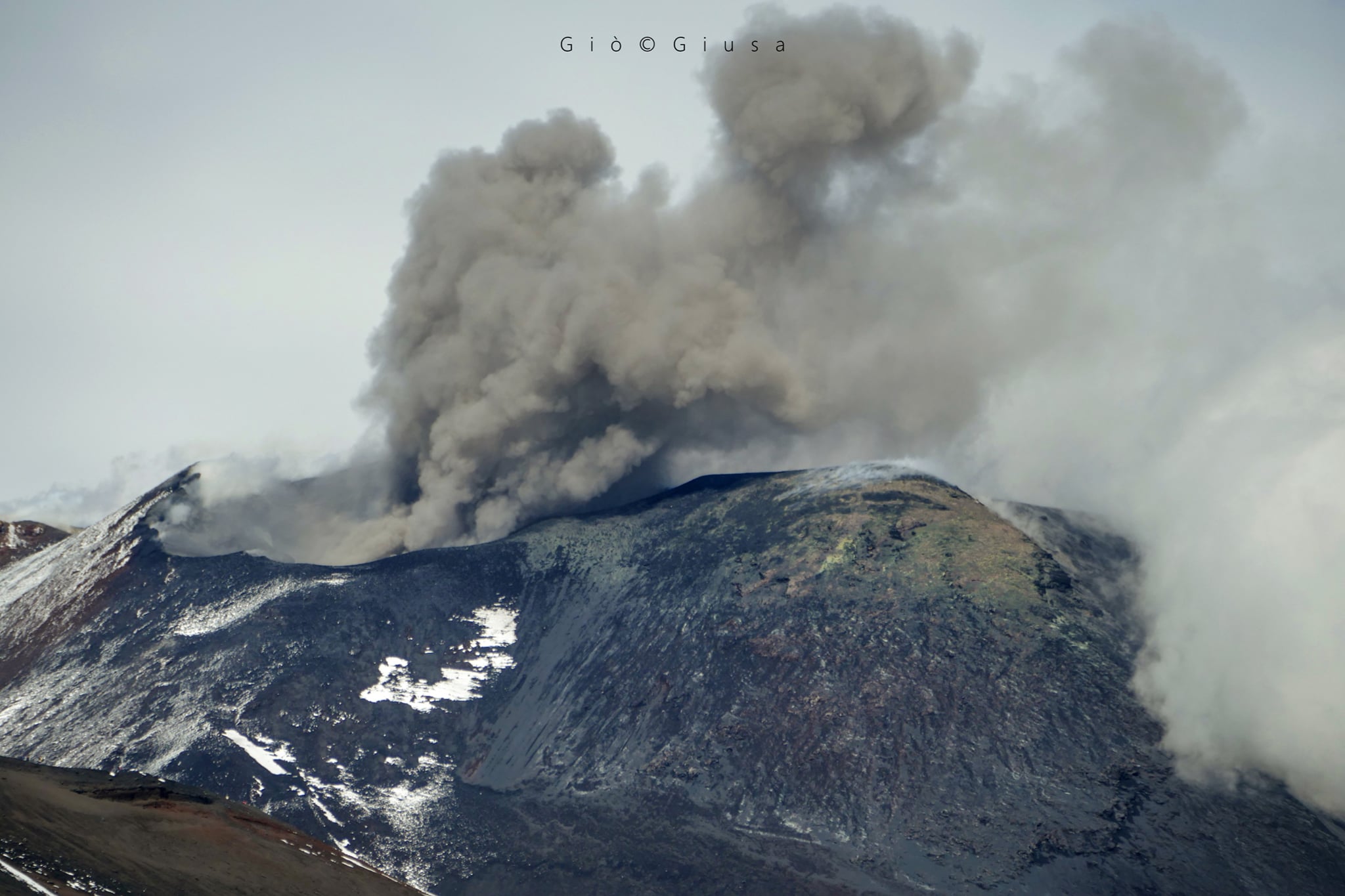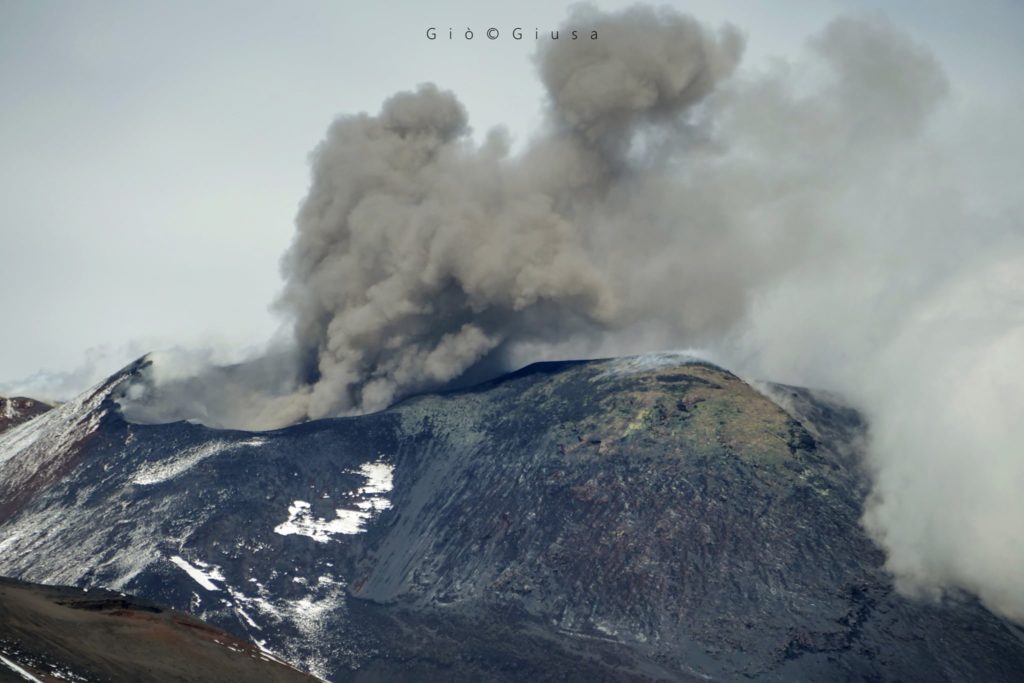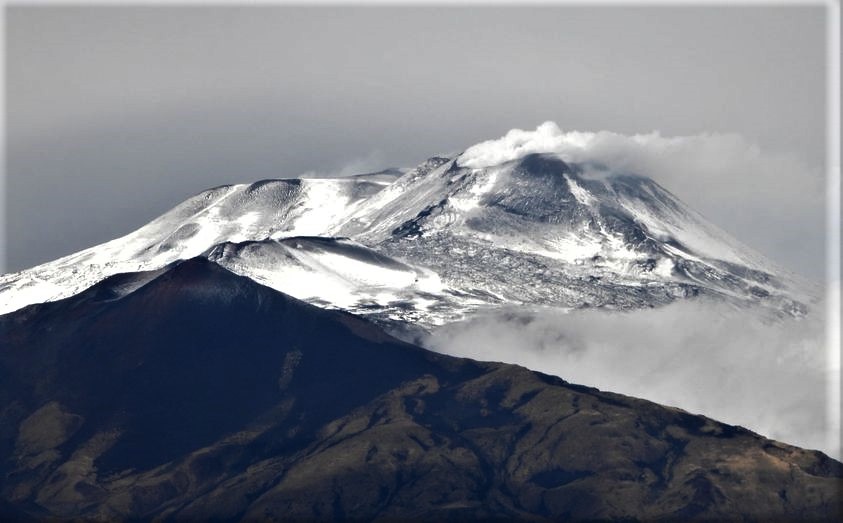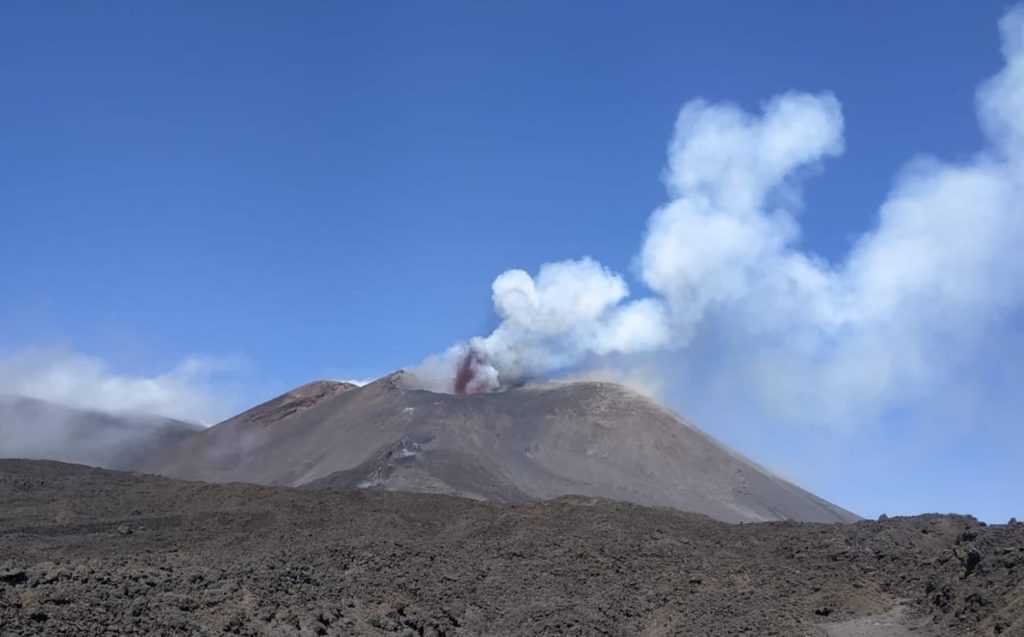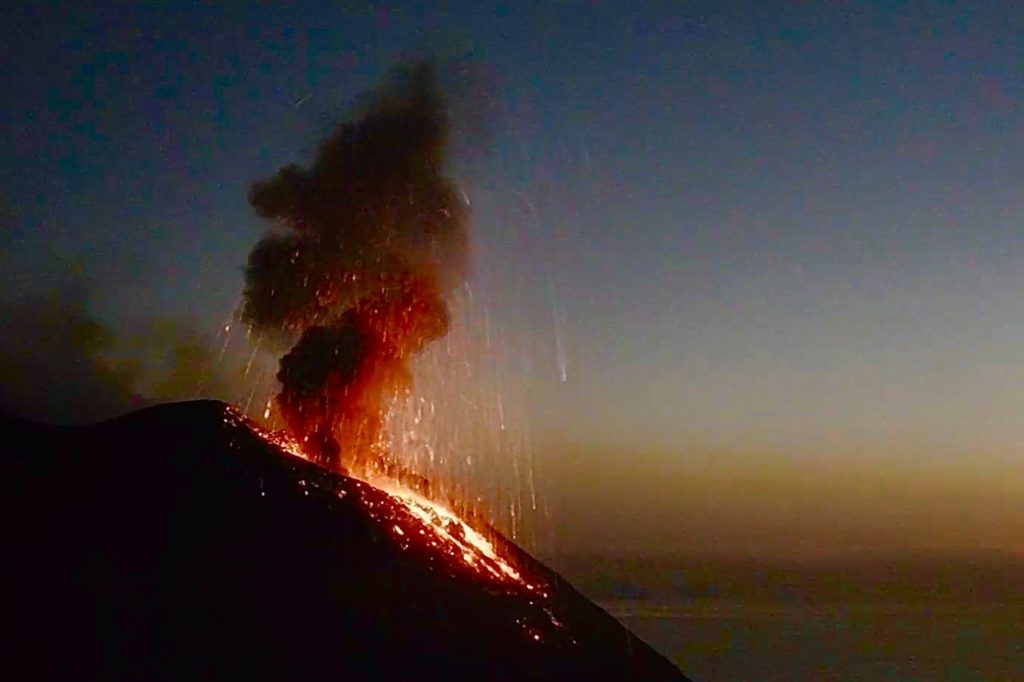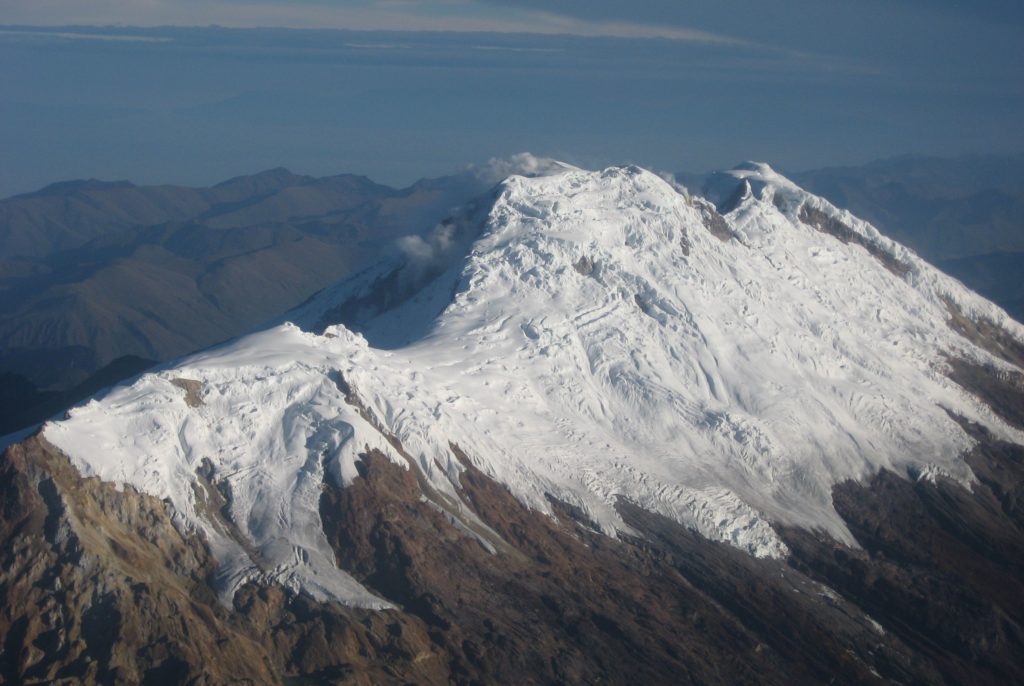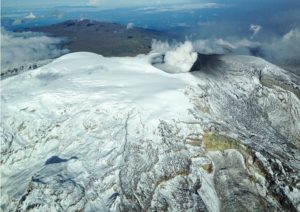October 14 , 2020.
Italy / Sicily , Etna :
Weekly bulletin, from October 05, 2020 to October 11, 2020
(issue date October 13, 2020)
SUMMARY OF THE STATE OF ACTIVITY
In the light of surveillance data, it is highlighted:
1) VOLCANOLOGICAL OBSERVATIONS: Strombolian activity of variable intensity at the New Southeast Crater with discontinuous emissions of volcanic ash and emission of pieces of lava.
Strombolian activity in the Northeast Crater. Ordinary degassing at the Voragine crater with rare and light emissions of diluted ash. Degassing at the Bocca Nuova crater.
2) SEISMOLOGY: Seismic activity of modest fracturing. Amplitude of the tremor mainly on average values which sometimes reached high values.
3) INFRASONO: low infrasonic activity.
4) DEFORMATIONS: During the last week, the evolution of the time series of the Etna soil deformation monitoring networks did not show any significant changes, with the exception of some GNSS stations in the North sector. -East. In addition, only certain stations of the inclinometric network recorded a modest permanent deformation associated with seismic activity.
5) GEOCHEMISTRY: the flow of SO2 occurs at an average level
HCl flux: Data not available, the latest measurements are at an average level. Soil CO2 flux is at low degassing levels.
The partial pressure of dissolved CO2 does not show significant changes.
No update is available for the C / S report (last measurement of 07/17/2020).
The isotope ratio of helium is on average values (last update of 09/22/2020).
6) SATELLITE OBSERVATIONS: The thermal activity in the summit area is at a medium-low level.
VOLCANOLOGICAL OBSERVATIONS :
During the week, the monitoring of the volcanic activity of the summit craters of Etna was carried out through the analysis of the images of the surveillance cameras of the INGV, Osservatorio Etneo (INGV-OE) and by the staff of the INGV-OE in the field. The first days of the week were characterized by discontinuous cloud cover, which limited observations.
In particular, Strombolian activity at the New Southeast Crater was variable both in the intensity and frequency of the explosions, and in the type of products expelled. The activity, in fact, was characterized by discontinuous ash emissions, but also by the emission of gases and the launching of fragments of lava which often exceeded the edge of the crater of the slag cone. Between the evening of October 5 and October 6, and primarily from around 05:00 UTC on the 6, Strombolian activity intensified, fueling a visible cloud of ash dancing in the early hours of the day on October 7. The eruptive cloud dispersed near the New Southeast Crater due to the action of the wind, in the distal zone it rose about 4.5 km, dispersing to the east.
In general, on October 7, activity at the New Southeast Crater was markedly variable in intensity. At around 4:00 pm UTC, the increase recorded in the morning and the associated ash cloud were no longer observable; however, after about 30 minutes a further moderate and variable intensification of Strombolian activity again produced a dense ash cloud. The cloud, in the distal zone, rose for about 4.5 km, dispersing to the east-south-east.
INGV-OE field staff reported ash fallout at the Citelli refuge. From the early morning hours of October 8, the increase in explosive activity at the New Southeast Crater was no longer observable, however Strombolian activity showed variable character for the rest of the week, fueling emissions of discontinuous and light ash which dispersed rapidly. in the summit area.
During an inspection carried out by INGV-OE personnel, using remote sensing techniques with drones, visible and thermal images of the Etna summit area were acquired on October 9. In addition to the eruptive activity, the images that separated the many active vents of the NSEC were no longer observable, observed during the last drone flyover carried out in July 2020.
During the observation period, the North – East Crater fed an intracrater Strombolian activity. In detail, from observations made with a drone on October 9, it was possible to observe that inside, the NEC had three cones of slag with a diameter varying between approximately 30 and 40 m and a height about 10 m from the bottom of the crater. In addition, it was possible to observe that the eruptive activity was fueled by up to four active vents characterized by Strombolian activity with projection of projections. From the thermal images, an intense intra-crater fumarolic activity was also observed.
During the week studied, the Voragine Crater was characterized by ordinary degassing and rare emissions of very dilute volcanic ash which dispersed rapidly in the summit area. The crater of Bocca Nuova only showed degassing.
Source : INGV.
Photos : Gio Giusa , Boris Behncke , Guide Alpine vulcanologiche Etna ( 01 /10/2020 ) , Gio Giusa.
Italy , Stromboli :
Weekly bulletin, from October 05, 2020 to October 11, 2020
(issue date October 13, 2020)
SUMMARY OF THE STATE OF ACTIVITY.
In the light of surveillance data, it is highlighted:
1) VOLCANOLOGICAL OBSERVATIONS: Normal explosive volcanic activity of Strombolian type on medium-low and medium levels (6-11 events / h), in particular activity of medium-low intensity in the area of the northern craters zone and medium-high in the Center-South zone.
2) SEISMOLOGY: The seismological parameters do not show significant variations.
4) DEFORMATIONS: The island’s soil deformation monitoring networks did not show any significant changes to report for the period under review.
5) GEOCHEMISTRY: Medium-low SO2 flux.
There are no updates on the soil CO2 flux data.
C / S Ratio – Data not available. The latest values are at medium-low levels (5.45, measurements from 13/09/2020).
Helium isotope ratio – The latest measurements (05/10/2020) are tested on average values, on a slightly increasing trend.
6) SATELLITE OBSERVATIONS: The thermal activity in the summit area is at a medium-low level.
VOLCANOLOGICAL OBSERVATIONS
During the observation period, the eruptive activity of Stromboli was characterized by the analysis of the images recorded by the surveillance cameras INGV-OE located at 190 m, Punta dei Corvi and 400 m.
Observations of inspections.
On October 7-11, researchers from the INGV-OE of Catania and the HPHT Lab of INGV-Roma1 carried out observations of the explosive activity and the morphology of the craters through direct observations, cameras and drones from Pizzo Sopra la Fossa and shelters at an altitude of 800m. It was observed that in the area of the N crater, the N1 crater produced activity from 4 vents, 2 placed inside the crater and two placed on small hornitos (N1H1-N1H2) facing the Sciara del Fuoco and which arose between the two craters N1 and N2 at an altitude of about 785 m. The activity generally consisted of Strombolian explosions lasting a few tens of seconds, accompanied by ash emissions from a vent inside the N1 crater which often exceeded the height of 150 m, and by projections of the two hornitos. The N2 crater was mainly characterized by prolonged gas emissions associated with loud roars and sometimes modest expulsions of ash and shreds of magma, while both hornitos N2H1 and N2H2, the latter located at an altitude of 775 m, produced shreds of lava. The Center – South crater area was characterized by abundant degassing which obstructed its visibility and from which, in the first days of observations, no roar was heard that could indicate explosive activity. On October 11, sporadic ash emissions from the southernmost sector (S2) associated with emissions of coarse materials (probably lithic) were observed; the S1 vent also produced episodic and intense ash emissions, while occasional emission activity associated with modest throwing activity was observed at the crater C vent.
In the area of the North crater, the N1 crater, with three emission points, produced explosions of low to medium intensity (less than 150 m high) emitting coarse materials (lapilli and bombs) sometimes mixed with materials fine (ash). Vent N2, with two emission points, showed mainly low intensity explosive activity (less than 80 m in height) emitting coarse materials. The average frequency of the explosions varied from 6 to 10 events / h.
In the Center-South zone, the explosions emitted mainly fine materials, sometimes mixed with coarse materials, with a medium-high intensity (the products emitted often exceeded 250 m in height).
The frequency of the explosions varied from less than 1 to 2 events / h.
Source : INGV.
Photos : Webcam , Stromboli adventures.
Peru , Ubinas :
Analysis period: October 5 to 11, 2020, Arequipa, October 12, 2020
Alert level: YELLOW
The Geophysical Institute of Peru (IGP) reports that the Ubinas volcano (region of Moquegua) continues to record a slight increase in seismic activity during the analysis period; therefore, it is suggested that the authorities and the public pay attention to the bulletins published by the IGP.
During the period of analysis, the occurrence of 17 volcano-tectonic (VT) earthquakes with magnitudes less than M1.3 was identified, associated with rock degradation processes that occur at the inside the volcano. On average, 2 earthquakes were recorded per day. Likewise, 5 seismic signals were recorded, associated with movements of volcanic fluids (gas, mainly water vapor). Within these, 2 « Tornillos » type events were recorded.
Surveillance cameras recorded columns of volcanic gas and water vapor that reached heights of up to 400 m above the summit of the volcano. These emissions dispersed towards the eastern sector of the volcano.
Monitoring of the deformation of the volcanic structure, using GNSS equipment (processed with fast orbits), does not show significant changes. Satellite monitoring, carried out through the SENTINEL, OMI-NASA (SO2 gas) and MIROVA (thermal anomalies) systems, does not record any anomalies.
RECOMMENDATIONS
• Stay informed at all times of the volcanic activity of the Ubinas thanks to the bulletins published by the IGP: (http://www.igp.gob.pe/servicios/centro-vulcanologico-nacional/).
• Do not approach within a radius of less than 4 km around the crater of the volcano.
Source et photo : IGP.
Colombia , Nevado del Huila :
Weekly activity bulletin of the Nevado del Huila volcano
The activity level of the volcano continues at Yellow Activity Level or (III): changes in the behavior of volcanic activity.
Based on the analysis and evaluation of the information obtained through the monitoring network of the Nevado del Huila volcano during the week of October 6 to 12, 2020, the COLOMBIAN GEOLOGICAL SERVICE – Volcanological and Seismological Observatory of Popayán reports that:
During the period evaluated, 201 seismic events were recorded, of which 127 were related to rock fracturing processes (type VT) and 74 to fluid dynamics in volcanic conduits.
Of these, 72 were classified as long-period events (LP type), one (1) as a hybrid event (HB type) and one (1) as a tremor type event, (TR type) with low energy input. From the seismicity recorded during the week evaluated, the occurrence of a VT type earthquake on October 7, 2020 at 10:30 p.m. local time (October 8, 2020, at 03:30 UTC) of magnitude 4.1 is distinguished, located 17 km away northeast of the central peak at a depth of 9 km, which has been reported to be felt in the departments of Tolima, Valle del Cauca, Cauca, Huila and Cundinamarca. The recording of this seismic event is part of the behavior associated with the volcano and does not compromise its stability.
Images obtained during the week using web cameras from Caloto, Tafxnú, Maravillas and La Palma showed weak degassing of the volcanic system.
Sensors for monitoring soil deformation, magnetic fields and infrasound waves did not record variations associated with changes in volcanic activity.
Source : SGC.
Photo : SGC 2007 .

